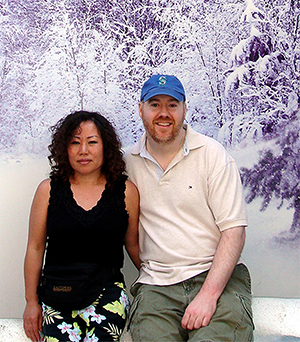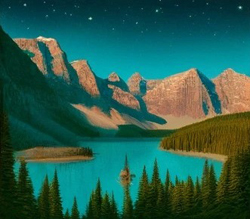
 Photography Tips for Everyday Moments
Photography Tips for Everyday Moments
The most extraordinary beauty is often found in ordinary moments. In this series, William Stanek helps you see the world through a new lens, transforming everyday experiences into stunning photographic memories.

Transform your life with practical wisdom. Discover William Stanek's 'Living Well' series—your guide to a balanced and fulfilling life.
Discover William Stanek's Exclusive Art Collection
Explore and purchase the stunning art featured on this site. Own a piece of William Stanek's unique and captivating artwork today!
(May 8, 2025) Telling Stories with Shadows: The Subtle Art of Chiaroscuro
Chiaroscuro, a term borrowed from the world of painting, refers to the dramatic interplay of light and shadow. In photography, this technique can transform ordinary scenes into something deeply evocative, adding a sense of depth, mystery, and drama. By skillfully balancing light and shadow, you can create images that not only capture a moment but also tell a story, drawing the viewer into a world where much is suggested and little is explicitly revealed. Here, we’ll explore the art of chiaroscuro, focusing on high-contrast techniques, the subtle use of shadows, and composing with light and dark to create dynamic, powerful images.
Introduction: The Power of Light and Shadow
Light and shadow are fundamental to photography—they’re the building blocks of any image. But when you use these elements with intention, they become much more than just tools for exposure and focus. Chiaroscuro, the technique of using stark contrasts between light and dark, invites you to explore the emotional and narrative potential of shadows. This approach can turn a simple scene into something dramatic, mysterious, or even ominous, all depending on how you manipulate the interplay between light and darkness.
Chiaroscuro photography is not just about creating high-contrast images; it’s about understanding how shadows can shape a composition, evoke mood, and tell a story. Whether you’re capturing a portrait, a still life, or an everyday moment, mastering this technique will allow you to infuse your photos with a sense of depth and intrigue, drawing viewers in and holding their attention.
In this article, we’ll guide you through the essentials of chiaroscuro in photography, from creating drama with high contrast to using subtle shadows to suggest rather than show, and how to compose your images with a delicate balance of light and dark.
High Contrast Techniques: Creating Drama Through Stark Contrasts
High contrast is at the heart of chiaroscuro photography. By placing bright highlights against deep shadows, you can create a striking visual effect that adds drama and intensity to your images. Here’s how to master high-contrast techniques:
Finding the Right Light: The key to successful chiaroscuro is strong, directional light that casts deep shadows. Natural light is often the best source, particularly when it’s low in the sky, like during the golden hours of early morning or late afternoon. This light creates long shadows and sharp contrasts that are perfect for chiaroscuro. If you’re shooting indoors, a single light source, such as a window or a lamp, can create a similar effect.
Emphasizing Highlights: In chiaroscuro, highlights are used sparingly but effectively. The goal is to illuminate specific areas of your subject while leaving the rest in shadow, creating a sense of mystery and focus. Position your light source to highlight key features—such as the contours of a face, the edge of a hand, or the outline of an object—while allowing the rest of the scene to fall into darkness. This selective lighting draws the viewer’s eye to the illuminated areas, creating a powerful focal point.
Deep Shadows for Contrast: The contrast between light and dark is what gives chiaroscuro its dramatic impact. To achieve deep shadows, use your camera’s exposure settings to underexpose the image slightly, ensuring that the dark areas remain rich and black rather than gray. In post-processing, you can enhance this effect by increasing the contrast or adjusting the shadows and blacks to deepen the darkness even further. The key is to create a clear separation between the light and dark areas, enhancing the sense of depth and dimension in the image.
Pro Tip: When shooting in high contrast, consider using manual exposure mode to have full control over the light and shadow in your image. This allows you to adjust the exposure precisely to create the desired effect, rather than relying on your camera’s automatic settings, which might try to balance the light and dark areas more evenly.
Exercise: Choose a subject that lends itself to high-contrast photography, such as a portrait, a still life, or an architectural detail. Use a strong, directional light source to create deep shadows and bright highlights. Experiment with different angles and exposures to emphasize the contrast, and reflect on how this approach changes the mood and impact of the image.
Subtle Shadows: Using Shadows to Imply Rather Than Reveal
While high contrast is a hallmark of chiaroscuro, shadows can also be used subtly to suggest rather than show. This technique adds a layer of mystery and intrigue to your photos, inviting the viewer to fill in the gaps with their imagination.
Implying Shape and Form: Shadows can be used to imply the shape and form of a subject without fully revealing it. For example, instead of showing a person’s face, you might capture just the shadow of their profile on a wall, leaving their identity and expression to the viewer’s imagination. This technique can be particularly effective in storytelling, as it allows you to create a sense of presence and narrative without being explicit.
Creating Atmosphere with Soft Shadows: Soft, diffused shadows can create a moody, atmospheric effect that is less about drama and more about subtlety. This is often achieved with indirect light, such as on an overcast day or in a softly lit room. The shadows in these images are gentle and gradated, creating a sense of depth and mystery without overwhelming the scene. Soft shadows are ideal for creating a quiet, contemplative mood, where the emphasis is on the interplay of light and shadow rather than stark contrasts.
Suggesting Motion and Time: Shadows can also be used to suggest motion and the passage of time. For example, the long shadow of a moving figure can convey a sense of movement, while the changing angle of shadows throughout the day can indicate the passage of time. These subtle uses of shadow add layers of meaning to your images, transforming simple scenes into dynamic compositions.
Pro Tip: To create soft shadows, use a diffuser or shoot through a translucent material like a white curtain or frosted glass. This will soften the light and create gradual transitions between light and shadow, adding subtlety to your composition.
Exercise: Capture a series of photos that use shadows to imply rather than reveal. Focus on creating images where the shadow tells part of the story, leaving the rest to the viewer’s imagination. Experiment with soft, diffused lighting and reflect on how these subtle shadows change the mood and narrative of the scene.
Composing with Light and Dark: Balancing Light and Shadow for Dynamic Compositions
In chiaroscuro photography, the balance between light and dark is crucial to creating dynamic compositions. It’s not just about placing light and shadow in your image, but about how they interact to create a harmonious and engaging scene.
Leading the Eye with Light: In any composition, light naturally draws the viewer’s eye. Use this to your advantage by positioning the brightest areas of your image where you want the viewer to focus. This could be the face of a subject, a key detail in a still life, or an architectural feature. By strategically placing light, you can guide the viewer’s gaze through the image, leading them from one point of interest to the next.
Balancing Light and Dark: While chiaroscuro often emphasizes strong contrasts, it’s important to balance these elements within the composition. Too much dark space can overwhelm the image, while too much light can reduce the impact of the shadows. Aim for a composition where the light and dark areas complement each other, creating a sense of equilibrium. This balance doesn’t necessarily mean equal amounts of light and dark, but rather that the two work together to create a cohesive, visually interesting image.
Negative Space: Shadows can also be used as negative space in your composition. Negative space refers to the empty or unoccupied areas of an image, which can be just as important as the areas filled with detail. By using shadows as negative space, you can create contrast and highlight the subject, adding depth and focus to the image. Negative space can also contribute to the mood of the photo, making it feel more open, minimalistic, or contemplative.
Using Light to Define Shape: In chiaroscuro photography, light is often used to define the shape and form of the subject. This can be achieved by positioning the light source to create strong, directional shadows that highlight the contours and lines of the subject. Whether it’s the curve of a face, the angle of a building, or the texture of fabric, using light to define shape adds dimension and interest to your composition.
Pro Tip: Pay attention to the edges of your light and shadow areas. Sharp, well-defined edges can create a more dramatic effect, while soft, gradual transitions between light and dark can add subtlety and depth. Use this to control the overall feel of your composition.
Exercise: Compose a series of images that explore the balance between light and dark. Focus on using light to lead the viewer’s eye, define shapes, and create dynamic compositions. Experiment with different ratios of light to dark and reflect on how these choices affect the mood and impact of your photos.
The Storytelling Power of Shadows: Evoking Emotion and Mystery
Chiaroscuro photography is more than just a technique—it’s a powerful way to tell stories, evoke emotions, and create a sense of mystery in your images. By mastering the interplay of light and shadow, you can transform everyday scenes into something dramatic, poignant, or even haunting.
Creating Emotion Through Light and Shadow: The use of light and shadow can evoke a wide range of emotions, from tension and fear to tranquility and introspection. For example, a dark, shadowy image with a single beam of light can create a sense of isolation or loneliness, while soft, diffused shadows might evoke calmness or serenity. Consider the emotions you want to convey in your image and use light and shadow to enhance that feeling.
Adding Layers of Meaning: Shadows can add layers of meaning to your photos, suggesting what isn’t seen as much as what is. A shadow can hint at a presence outside the frame, suggest hidden depths or unseen forces, or imply a narrative that the viewer must piece together. This use of shadows adds complexity and intrigue to your images, encouraging viewers to engage more deeply with the story you’re telling.
Pro Tip: Think of light and shadow as characters in your story. Just as a character’s actions and appearance contribute to the narrative, the way you use light and shadow can shape the story your image tells. Be intentional about how you use these elements to support the mood, theme, and message of your photo.
Exercise: Create a series of chiaroscuro images that focus on storytelling. Use light and shadow to evoke specific emotions, suggest hidden meanings, or create a narrative within the frame. Reflect on how these elements contribute to the story your image tells and how they affect the viewer’s interpretation.
Conclusion: The Subtle Art of Chiaroscuro
Chiaroscuro is a subtle but powerful tool in photography, offering endless possibilities for creativity and expression. By mastering the use of light and shadow, you can create images that are not only visually striking but also emotionally resonant, drawing viewers into a world of depth, mystery, and drama.
As you continue to explore chiaroscuro in your photography, remember that it’s not just about technical skill—it’s about storytelling. Use light and shadow to shape your narrative, evoke emotions, and create a connection with your audience. Whether you’re capturing the quiet beauty of a still life, the drama of a portrait, or the mystery of an everyday moment, chiaroscuro allows you to transform the ordinary into something extraordinary.
Share your chiaroscuro photography with us on Instagram using #ShadowStories. We’re excited to see how you’re using light and shadow to tell powerful stories through your lens.

Join William at the crossroads of technology, business, and leadership, where true influence isn't about titles - it's about inspiring action, driving change, and guiding others with integrity. Discover how authentic leadership can transform not just careers, but entire industries.
Bring Inspiration Home
Enhance your space with William Stanek's evocative art. Each piece is crafted to inspire and uplift your everyday life.

Support The Lights of Paris by Robert Stanek, William Stanek's pen name! Through vivid historical detail and deeply moving character stories, Robert takes readers on an unforgettable journey through one of history’s most transformative times.
















